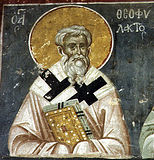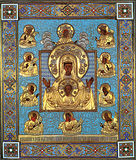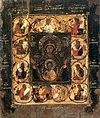

| Previous day | Next day |
| Old Style
March 8
|
Monday |
New Style
March 21
|
|
3rd Week of Great Lent.
Tone 6.
Great Lent. |
Monastic rule: xerophagy (bread, uncooked fruits and vegetables).
|
![]() St. Theophylactus, bishop of Nicomedia (842-845).
St. Theophylactus, bishop of Nicomedia (842-845).
Apostle Hermas of the Seventy (1st c.). Hieromartyr Theodoretus, priest, of Antioch (361-363). Sts. Lazarus, founder (1391) and Athanasius, monk (15th c.), of Murmansk Monastery (Karelia). St. Andronicus (Lukash), schema-archimandrite of Tbilisi, Georgia, elder of Glinsk Monastery (1974).
“Kursk Root” Icon of the Sign of the Most Holy Theotokos (1898).
St. Felix of Burgundy, bishop of Dunwich and enlightener of East Anglia (ca. 648). Martyrs Quintilian and Capatolinus, at Nicomedia. St. Julian, archbishop of Toledo (690). St. Paul the Confessor, bishop of Plousias in Bithynia (ca. 840). St. Tarasius the Wonderworker, of Lycaonia.
Repose of Blessed Basiliscus of Uglich (1863) and Archbishop Vitaly (Maximenko) of Eastern America (1960).
Thoughts for Each Day of the Year
According to the Daily Church Readings from the Word of God
By St. Theophan the Recluse

Friday.
The souls of the righteous are in the hand of God (Wisdom 3:1). But in whose hand are the souls of sinners? The Saviour said to the apostles that satan seeks to sift them like wheat, that is, he seeks to knock them from the right path, to take them into his hands and do with them what he wants. That is why everyone turning away from the Lord is in the hands of satan, and he sifts them and casts them wherever he desires. Due to this the heads of sinners are constantly spinning, because the enemy, dragging them here and there, does not give them a chance to come to their senses. As soon as the enemy notices that someone is starting to have second thoughts, he starts to shake him even more strongly, so that his head again becomes clouded and his thoughts become scattered.
Monday (3rd week of Lent).
The fear of the Lord is to hate evil (Prov. 8:13);[1] and if it hateth evil, it will drive it away; if it drives it away, the soul will be cleansed of it, and will thus appear righteous
before the Lord. This is everything that we now seek with such effort. Thus, restore the fear of God in yourself and maintain it, and you will possess the most powerful means for self-healing. The fear of the Lord will not allow you to sin, and it will force you to do every good thing on every possible occasion. Then you will fulfil the commandment: Depart from evil and do good (Ps. 34:14), which the prophet gives to those seeking true life. How can one attain fear of God? Seek and ye shall find (cf. Matt. 7:7). We cannot say in this regard, “Do this,” or “Do that;” the fear of God is a spiritual feeling, secretly conceived in the heart that is turning to God. Reflection helps, and the effort to have this feeling helps; but in fact it is given from the Lord. Search it out like a gift and it will be given to you. When it is given, then listen to it without contradicting, and it will correct all evil within you.[2]
[1]The Slavonic for Prov. 8:13 reads: The fear of the Lord hateth evil.
[2]“All evil within you”—here St. Theophan refers to the word in the quote from Prov. 8:13, which in the KJV slightly differs from the Slavonic.
Articles
 Apostle Hermas of the SeventyThe Holy Apostle Hermas of the Seventy was bishop at Philippopolis, and died a martyr in the first century. |
 Hieromartyr Theodoritus of AntiochSaint Theodoritus was a presbyter and keeper of sacred vessels at the cathedral church in Antioch. |
 Venerable Athanasius of MuromSaint Athanasius was igumen at the monastery of Saint Lazarus during the mid-fifteenth century. |
 Icon of the Mother of God “Kursk-Root”The Kursk Root Icon of the Mother of God “Of the Sign” is one of the most ancient icons of the Russian Church. |





